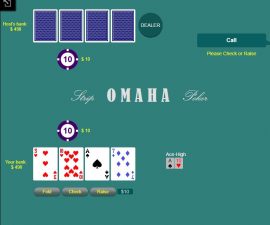Learning how to play poker is something most gamblers would like to do – but often times, the learning process can be long, tedious, and drawn-out, due to uninformative, unhelpful information. That’s why, in this “poker for beginners” guide, we’re going to show you the best way to learn to play poker, and we’ll be […]
Learning how to play poker is something most gamblers would like to do – but often times, the learning process can be long, tedious, and drawn-out, due to uninformative, unhelpful information. That’s why, in this “poker for beginners” guide, we’re going to show you the best way to learn to play poker, and we’ll be focusing on Texas Hold ‘Em – the most common form of poker around today.
We’ll begin by covering some of the basic rules surrounding poker – how to play, hand rankings, and so on – and we’ll delve deeper into the mathematics and strategy side of things later on in this poker tutorial. So, if you’re looking for a “how to play poker for beginners” guide, make sure you pay attention – we’re going to get started!
Poker for Beginners: The Basics
The basic objective of poker is to make the best poker hand possible, and beat all other players who are playing in a hand with you. We’ll look at poker hand rankings a little later on in this poker guide – but first, let’s take a look at how poker is actually played.
As soon as all players have assembled at the table, the very first decision to be made is deciding who will start off as the dealer. This can either be done on a volunteer basis, or by dealing everyone a card, and the one with the highest value will be the dealer. Once chosen, the dealer will be indicated by what is called a “Dealer Button” that is placed just in front of them.
The player with the dealer button gets to act last in all betting rounds except the preflop – a huge advantage as you get to witness what everyone else does first, before making your decision. As such, the dealer button is rotated clockwise around the table to the very next player at the end of each hand, so that everyone will get to be in this advantageous position too.
Note, in both an actual casino and online poker where there is a designated professional dealer or a computer dealer, the player with the dealer button doesn’t physically deal the cards, but rather just signifies to everyone else, including the dealer, who is acting as the ‘nominal’ dealer for that hand. This lets the dealer knows who to deal the first card to (the first player to the left of the dealer button), and also who gets to act last, except, as we’ve already mentioned, in the preflop stage where the big blind is the player to act last.
Once the dealer button has been positioned, the first players to the left of the button will have to put down the ‘small blind’ and the very next player the ‘big blind’. (scroll down to the next section to get a better understanding on what ‘blinds’ are). When that’s done, it’s time to start dealing out the cards.
The first player to the left of the button is dealt one card face down, and this is repeated clockwise around the table, one card at a time, until every player has 2 face down cards, also known as the hole cards. After all players have been given two cards, the first round of betting, known as the ‘preflop’ betting round commences.
Preflop Betting Round
After all players have been given their hold cards, they now have to look at their cards and decide what they want to do. The first to act is the player directly left of the big blind, and then the action cycles through every player in a clockwise direction back to the big blind, so that everyone has had a chance to act.
Every player has the same choice of actions when it’s their turn – Fold, Call (‘Check’, in the case of the big blind for this particular round), or Raise.
When it’s time for the big blind to take action, there are several actions that s/he can take, depending on what the previous players have done:
If everyone else had simply ‘called’ the big blind, s/he can ‘check’ (add no additional bet) to stay in the round. Or, he can ‘raise’ (add more bet – usually at least double the amount of the big blind), in which case betting continues around the table once again until everyone calls the current bet, or even re-raise again. Each cardroom will have their own specific limit of how many re-raises can be made in one betting round – usually 3 or 4.If someone had ‘raised’, then s/he will have to ‘call’ the new bet amount, or re-raise.Lastly, they can also ‘fold’. Usually, if everyone else had just called the big blind, there’s no reason for the player to fold, as they do not have to invest any more money in to the pot, and therefore should stay until the next betting round.
Once everyone has had a chance to act at least once, AND everyone who is still in the game (not folded) has placed the same amount of bet, the current betting round ends and then the next round begins.
The Flop
Three new cards are dealt face up in to the centre, and are known as “the flop”. All players are able to use any number of these community cards to improve their hand, and once they’ve been dealt, yet another round of betting takes place.
Similar to the previous round, everyone takes turn in taking action, with two small differences.
The first difference is the initial player to kick off the betting round is now the first active player to the left of the button.
The second difference is in the choice of the available actions. The first player can either ‘bet’ (as there are no blinds, meaning no live bets, the player can initiate the betting round by making the very first bet) or ‘check’, whereby they pass the initiation decision to the very next player to their left, and remain in the game to act once again when the play comes back round to them, depending on what all the subsequent players do. If everyone else checked, then the game proceeds to the next betting round. If someone had betted, then the initial player to have checked will have to call the bet, raise, or fold.
Again, once everyone has had the chance to make at least once action and everyone has made the same amount of bet (or none, if everyone checked), the game proceeds to the next betting round.
The Turn and the River
One more card is dealt face up, known as the turn. This betting round is identical to the previous round, which is also identical to the next round, where the fifth and final card is dealt face up, known as the river.
The Showdown
If two or more players remain after the river betting round, these players then enter the showdown stage.
Typically, the person who initiated the betting in the river round is the first to reveal their cards. Then, going clockwise, all other remaining players can reveal their cards as well. However, if a player holds a losing hand to the ones already revealed, they do not have to show their cards, but rather can “muck” (throw their cards, face down, into the discard pile, so that no one will know what cards they had) their cards and conceded the pot.
If no one made a bet in the previous round, then the first player to the left of the button must reveal their hands first.
The winner is the player with the best hand, and they will be awarded the full pot. In the case of a tie, the pot is split between however many players share a tied hand.
Who Is the Winner?
Apart from the player(s) with the best hand in the final showdown round, another way a player can be determined is if there is only one player remaining before reaching the showdown round. So, if everyone but one folded in any of the previous betting rounds, then the remaining player will be the winner and is awarded the pot.
Big and Small Blinds
You may have heard people talking about the “big” and “small” blinds before, and if you’re sat there scratching your head wondering what the heck people are talking about, then keep reading.
An integral part of No-Limit Hold’em, the big and small blinds are tiny bets that are “forced” onto the two players to the left of the dealer. The big blind is usually the table’s minimum bet, and the small blind is half the big blind, so, say you were playing at a poker table with limits of $1/2, the big blind would be $2, and the small blind would be $1.
You may be wondering what the point of the blinds are – and there’s a few reasons why they’re included at most poker tables.
First off, they encourage action. There’s always money in the pot, so players are less tempted to sit back and wait for premium hands.
They’re also important in tournament structure, as, without them, players could simply refuse to play hands until they had pocket Kings or Aces.
Antes
Antes are generally found in high-stakes cash games, and in the latter stages of the tournaments. They’re similar to the big and small blinds, in that players don’t have a choice as to whether or not they put an ante in or not – and again, the reason why it’s used, is to both encourage action, and ensure that players aren’t just sitting out, waiting for premium hands.
Bluffing: A Beginner’s Guide
Bluffing is one of the core components of poker, and it’s the one you’re probably most excited – or most nervous about.
As a general rule of thumb, it’s not wise to try bluffing too much as a new player. The reasons for this are fairly self-explanatory. As there’s a good chance you’ll be playing against more experienced players, you don’t want to give away an advantage, where they could potentially see through your bluff and end up beating you.
This does, of course, have its uses, as many times they won’t expect you to bluff – but it’s probably worth taking your time with it before trying anything too rash.
So, what is a bluff?
Bluffing is the art of getting your opponent(s) to fold a better hand than yours, so that you can win the pot. Say, for example, you were chasing a flush, and you missed on the river. If there was a nice amount in the pot, you’d likely want to make a small bluff, hoping your opponent fold their hand.
Of course, your opponent could also have been chasing a flush – and if he or she is a good player, they could re-bluff you!
This is where things get pretty complicated, and if you want to avoid being bluffed, it helps to track the entire hand, so that you can re-play it in your mind if things get tricky at the river.
Bet, Check, Call, Raise, or Fold
As you’ll have noticed in the previous section, we talked a lot about betting, checking, folding, or calling. In the following section of this poker guide we’re going to look at what each of these terms means.
Betting
If the action is checked round to you, either preflop, on the flop, on the turn, or on the river, you can make what’s known as a bet. This is where you bet a certain amount of money, either trying to entice players in (when you have a strong hand), or to bluff them out (when you have a bad hand.)
If a player wants to continue in the hand, they can match your bet amount, but they can also raise you, which means they put even more money in – this, of course, then means you have to either call their raise, or fold your hand.
Checking
Players can choose to check, which means they don’t wish to place a bet. If they do decide to check, the action will move to the next player, at which point they can either check or bet.
Calling
If a player makes a bet, or a raise, you can decide to call. This is often known a “flat call”. It means you match their bet amount exactly.
Raising
You can raise the current betting amount by doubling the big blind amount, or any other amount that was predetermined for the style of game being played.
Folding
You can fold your hand at any time (provided the action is on you), and this is usually seen where an opponent of yours makes a bet, and you don’t fancy your hand enough to call.
Rules of Poker
While poker is relatively easy to play, there are some basic rules which should be followed. Failure to do so could result in you suffering a penalty – which usually is delivered in the form of having to sit out from one or more hands.
As part of this poker tutorial, we’ve included a few of the main and most important rules you should be aware of below.
(Note: These rules will generally only apply to when you’re playing poker in real life. When playing on the computer, the software generally stops you from making these mistakes, so you won’t need to worry about them. Still, it’s worth having an idea of them, in case you do ever decide to play at a land-based-casino.)
Folding Out of Turn: This is one of the biggest mistakes new players make, and if the action has not yet made its way round to you, you should never fold your hand, or announce any type of decision on what you’re going to do. If you do, your hand could automatically be folded for you – and repeat offenders may suffer a penalty of up to one orbit of the table.
Exposing One Or More of Your Hole Cards: This is something occasionally used by professionals, to get an idea of their opponent’s reaction. In some games, it’s acceptable – cash games – but in tournaments it’s a big no-no, and your hand could be declared dead if you do it continually. In most instances, however, if you expose your hand accidently, you will simply lose the ability to make aggressive actions – meaning you can only call, check, or fold to a bet.
Colluding with Other Players: This is perhaps the most severe mistake you can make in poker, and this is where you talk with other players about your hand. This could be in the form of chatting to a friend sat next to you, or it could take a more sinister form, where you’re actively cheating by texting a friend about what your hand contains.
Now, that’s just a few of the main rules within a poker game. As mentioned earlier, you generally don’t need to worry about them too much, as, when playing online, the poker software prevents you from making them – but if you do decide to play in “real life”, make sure to follow them, to avoid getting in trouble with the dealer or pit boss.
Poker Hands Guide
If you’re planning on playing poker for real money, it is, of course, beneficial to have a good idea of the hand rankings – and for your conversance, we’ve included a table, breaking down the various hand ranks. You can see the table below:
Poker Strategies
How to play poker for beginners – something that almost all new poker players ask.
The truth is, there’s no sure-stead way of learning how to play poker, and a lot of it comes from practice. That being said, there are ways that – as a newcomer to the game – you can improve your chances of winning (especially when playing against players who are also just starting out), and in the following section, we’re going to take a look at some of the main poker strategies around today.
Play Within Your Bankroll
As a general rule of thumb, you should try not to bring more than 5% of your total bankroll to the table, at any one time. Say, for example, you had a poker fund of £500. Ideally, you should avoid sitting down at a table with more £25.
Of course, in practice this is a little harder than it sounds, and it does require a high level of discipline – but it’s one of the best ways to avoid busting out too early, and will ensure you can keep playing, even after having a losing session.
Know When to Walk Away
Tilt – when you’re losing and start acting irrationally – is the bane of almost all poker players, and it’s one of the main ways in which players lose money. Now, tilting isn’t mutually exclusive to new players – even the world’s best professional experience tilting – but if you’re on a losing run, and feel that you simply can’t catch a break, the best thing to do is walk away from the table, and have some time off.
If you don’t, you’ll likely end up making rash decisions, and will almost certainly come to regret it later on.
Beginner’s Tips for Playing Poker
If you’re new to poker, it’s natural to feel overwhelmed at times. That’s why, below, we’ve compiled a few of our favourite tips you can follow, to ensure you minimize losses, and maximize wins.
Choose Your Starting Hands Wisely
If you try to play every hand under the sun, in the hopes of landing a fluke monster, you’re not only going to end up losing a lot of money, but you’ll also be far-more likely to attract the more aggressive players, who may well try to bluff you out of the important hands.
As a general rule of thumb, you should be aiming to play around 15-20% of hands – and even that number is a little on the high-side.
If you’re stuck on what hands constitute a “good hand”, remember that preflop, any pair is generally strong, along with two high-cards, like Ace-King, Ace-Queen, Ten-Jack, and King-Queen.
Know When to Call
It can be so easy to call opponents bets on the off-chance you have a winning hand, but if you adopt this strategy, you’ll find your chips slowly trickling off towards your opponent’s stack. This is another good example of why you should choose your starting hands wisely.
Try to avoid situations where you end up calling a bet just ‘for the sake of it’, and always THINK about why you’re making a call. Do you think your opponent could have hit his flush? Do you think he’s bluffing?
At least if you THINK about why you’re making a certain action, you’re getting valuable experience.
Don’t Be Afraid to Be Aggressive
While it’s a bad idea to call bets willy-nilly, it’s not always bad to bet regularly – and in doing so, you ensure that you’re keeping control of the table action.
If you choose to bet regularly, you become what’s known as “an aggressive player”, and if you choose to do so, you’ll want to bet both your strong hands, and your weak hands. This will avoid your opponent’s being able to pick up on traits, and will ensure you keep an air of mystery about your playing-style.
Don’t Tilt!
Losing is natural. It’s going to happen. You need to accept that fact if you want to become a good poker player.
When you lose a hand, instead of losing concentration, and beginning to play recklessly, take a moment to compose yourself, and think long-term. Sure, it may be tempting to call the next hand regardless of what you hold – but is this really going to help you win-money in the long run?
No! So, try to learn the art of discipline.
(This is something even the BEST poker players deal with – so the sooner you get a hold on it, the sooner you’ll be able to work your way up the ‘ability ranks’, and see yourself becoming a more successful, profitable poker player.)
Now, that’s just a few tips you can use to get started.
Conclusion
As you can see, learning how to play poker – and actually turn a profit from doing so – may not be the easiest task in the world, but it’s important for you to realize that you can do it – and the main driving force behind your journey towards becoming a success and profitable poker player, is the time and effort which you put in.
As with anything in life, the more time you spend practicing, the better you’ll get – and of course, while poker is a little different, in that you can lose money while learning – you don’t have to play in the big games, or risk too much money to become a successful player.
Follow the advice we’ve shared in this poker guide, and you’ll be well on your way to becoming a successful poker player.




